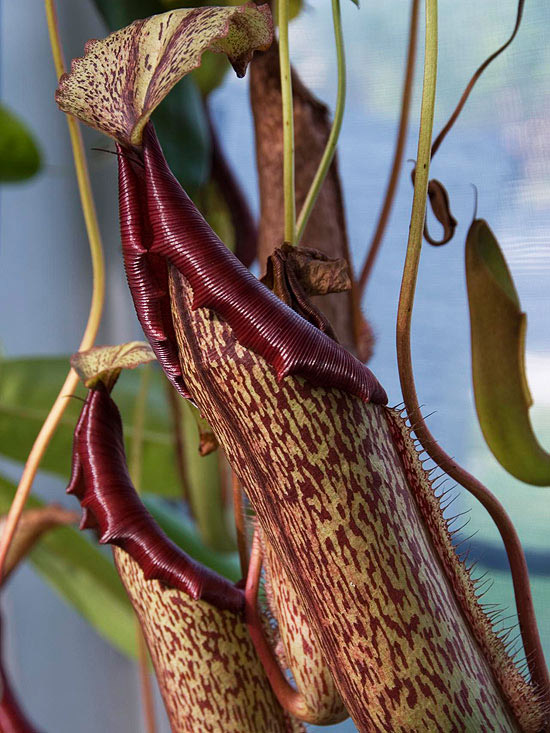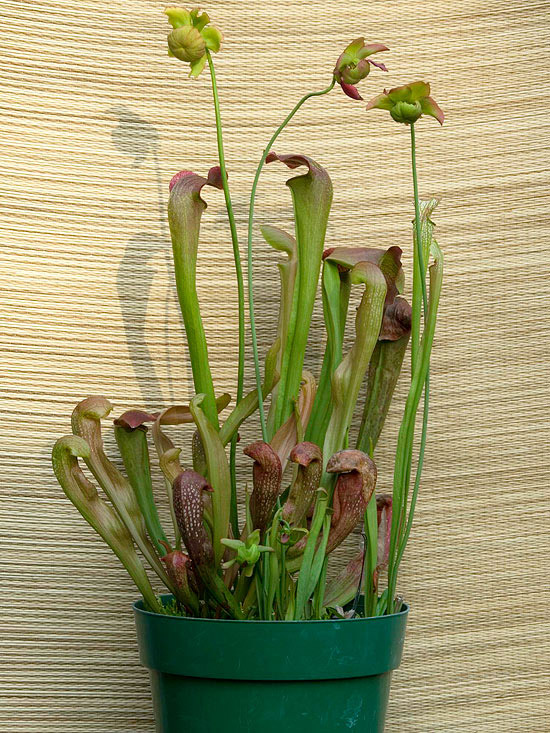






To grow insect-eating plants indoors, you'll be most successful re-creating the kind of conditions where they grow in nature. Beware, though: Insect-eating plants can be a bit more challenging to grow than the average houseplant. Insect-eating plants need high humidity, bright (but not direct) light, and a special growing medium that is moist and acidic. Use water purified by either distillation or reverse osmosis; tap water may contain too many additives or be too alkaline.
Is your insect-eating plant poisonous? Review our list to find out.
Humidity Requirements
Most homes have lower humidity than what carnivorous plants desire. To increase humidity, place them inside a fish tank with a lid or an enclosed glass terrarium. The plants also need air circulation, so keep a lid slightly ajar, remove it from time to time, or run a small fan in the fish tank.
Learn more about humidity guidelines for houseplants.
Insect-eating plants need bright light to grow properly. Indoors, place insect-eating plants in an east- or west-facing window that gets at least 1 to 2 hours of sun.
If your plants are potted inside a glass terrarium or fish tank, keep them out of direct sunlight so the heat that builds up inside doesn't burn your plants.
A fluorescent light fixture with two 40-watt tubes can be hung about 8 inches above the plants to provide more light.
Get more information about plant lights.
Most insect-eating plants are natives of boggy areas but don't grow in completely flooded conditions. They prefer acidic, well-drained soil. Don't use potting mix; it's too rich for these plants. They need no extra fertilizer.
Create your own growing medium by blending 1 part clean coarse sand with 2 parts sphagnum peat moss. If you plant inside a terrarium, place an inch of small rocks or coarse gravel below the potting medium to help with drainage.
Although their leaves collect sunlight to produce chlorophyll and make food via photosynthesis like other plants, insect-eating plants grow best when their diet is supplemented with insects.
Outdoors, this happens naturally. Indoors, it's best to release insects in a closed environment where the plants can attract and trap them. In most cases, the insects must be alive for the plants to eat them. Enzymes in the digestive system of the plant destroy the insects, and the plant absorbs the nutrients.
Test Garden Tip: Do not feed your insect-eating plants little bits of hamburger or other meats -- they have too much protein for the plants to digest.

Depending on the plant, insect-eating plants use several mechanisms to capture their prey: pits to fall into; sticky flypaper-type sections; snap traps; vacuum suction; and inward-pointing hairs that operate like a lobster trap.
There are hundreds of types of insect-eating plants but these are among the most commonly grown by gardeners. Never collect them from the wild; many are on protected or endangered species lists. Always check the source of your nursery's plants.
Hardy pitcher plants (Sarracenia spp.) are native in many boggy areas of North America. You can recognize them by their long necks and delicate hoods covering the openings.
Learn more about pitcher plants.
Sundew (Drosera spp.) leaves are rounded and covered with sticky, red tentacles. Insects attracted by the sweet smell trigger the tentacles to close and the plant to digest the insect.
Tropical pitcher plants (Nepenthes spp.) grow in tropical rain forests and have strappy leaves that end in a tendril holding a hanging water-filled pitcher. Because of their pendulous nature, these plants are best grown in hanging baskets.
Venus flytraps (Dionaea muscipula) grow slender leaves topped with clamshell-type flowers ringed with tiny "teeth." When an insect lands on the pink center of the clamshell, the hinge quickly shuts, trapping the prey inside.
Learn more about growing Venus flytraps.
Copyright © www.100flowers.win Botanic Garden All Rights Reserved